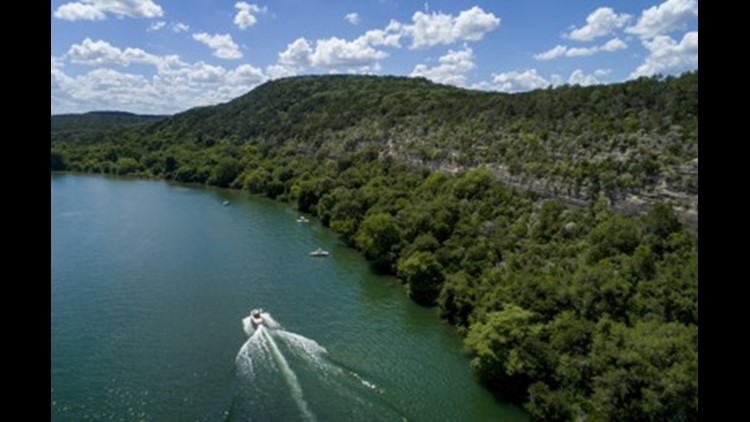(Austin American-Statesman) It’s an often photographed, picturesque spot synonymous with Austin: a scenic bluff that gives way to an expansive ridge with views of Lake Austin, the Pennybacker Bridge and the downtown skyline.
Now imagine the pristine, wooded tract on Shepherd Mountain with an array of development: an elevator ascending 180 feet from the lake to an upscale, 200-seat, ridge-top restaurant, plus a casual bar and grill; a 24-slip marina below; and homes and condominiums alongside mixed-use commercial development that could include office space and a boutique hotel.
All are part of the broad vision outlined in a recent zoning request for the 145 acres that Austin entrepreneur Jonathan Coon and his wife, Kirsten, bought last year, and where they eventually plan to build a home.
Located on a cliff near Loop 360 ( Capital of Texas Highway) and Courtyard Drive just west of the Pennybacker Bridge, the property is known as the Camelback tract. Camelback was the name of previous ownership entities that shrouded the land’s ownership by Exxon Mobil Corp. for 25 years.
The Coons are seeking to amend an existing type of zoning called a planned unit development, or PUD, that the city originally approved in 1986. Their plan includes turning half of the lakefront property into a public park and keeping development at least 2,000 feet from the Pennybacker Bridge.
Jonathan Coon said the cliff and lake below “is currently being used as a park. It should be a park, and we like the idea of having a great park next door to our neighborhood. It’s not a purely altruistic thing to do. We believe homeowners will like having a great park next door.”
Jonathan Coon, who founded 1-800 Contacts in the early 1990s, has not disclosed the purchase price of the land, a premier property that is one of the last undeveloped tracts on Lake Austin. The Travis Central Appraisal District this year valued the property at $33.7 million.
As with many developments in Austin, the Coons’ plans for the property are drawing opposition from some nearby residents.
Some members of the Bunny Run Neighborhood Association say they are concerned the project could create light, noise and lake pollution as well as add to traffic congestion at peak hours and threaten wildlife in the area through the destruction of habitat.
“Anyone in the city of Austin who cares about the quality of life and protecting what it is will be very concerned about this” proposal, said Lyra Bemis, president of the Bunny Run Neighborhood Association, a group with about 350 or so households as members. “Austin is very fortunate to have all these lakes — they’re jewels in the crown of this area.”
Bemis said she was not speaking for the association, which has not yet taken a formal position on the project.
Bill Nalle, a member of the group who lives directly across Lake Austin from the planned marina and elevator, echoed many of her reservations. Nalle said “Austin values” mandate that profits for a developer “should be secondary to the preservation of iconic view corridors, protection of Austin’s water supply and habitat preservation.”
However, Jonathan Coon said he has received “consistently positive feedback” for his plans from other neighbors and some city leaders, although he acknowledges that doesn’t mean “unconditionally supportive” in all cases.
“We’ve invested a lot of time with our neighbors over the last year to address their concerns,” Coon said.
Coon said the proposed zoning change would allow the land to be developed in a way that is superior to the 64 homesites that could be developed under a 1986 plan. That plan, he said, would allow for 12 houses to be built on the cliff side, with 12 points of access — such as trams or stairs — down to 12 separate boat docks on the lake.
“We have never said that trams would be easy to get approved, but whether it’s trams or stairs, 12 of anything along the cliff in this iconic location on Lake Austin would be less than ideal,” Coon said.
Coon said the elevator would be about 15 stories tall— “not as spectacular as opponents would like to make it out to be.”
“The vast majority of restaurant guests will arrive by foot or by car,” he said. “Arriving by boat is just another cool option for someone who has a reservation at the restaurant.”
At a recent meeting with neighbors, Coon said the 1986 plan had “no real water quality protection, no heritage tree protection, no setbacks for critical environmental features and no parkland dedication.”
His revised plan, Coon said, would leave 58 acres — 40 percent — as open space, preserve the cliff side and protect water quality, heritage trees and his neighbors’ views, among other attributes.
He said he would turn half of the property’s 3,000 feet of shoreline into a 13-acre public park.
“Instead of having 12 homes built along the cliff within 500 feet of the bridge and docks within 500 feet of the bridge on the lake below, we moved all development 2,000 feet away from the bridge on the cliff above and consolidated the boat slips to a single location that’s 2,500 feet away from the bridge on the lake below,” Coon said. “This preserves the cliff and lakefront below and turns it into a public park.”
Coon said Nalle’s home is 1,000 feet from where the elevator and boat docks are planned. Coon said Nalle’s position can be summed up “pretty easily and accurately — he doesn’t want to look at a boat dock across from his boat dock.”
Nalle said that Coon is mischaracterizing his opposition. “While some parts of the Camelback site could accommodate more intense development, this near-vertical bluff is just not one of them,” he said.
To make his proposal more palatable to some neighborhood groups, Coon said he paid $1 million for an option to buy a nearby parcel, the 45-acre Champions 3 tract, where about 300 apartments are planned. Coon said he intends to build senior-living housing on the Champions land, which he said would result in less traffic than the apartment project. In exchange, he is seeking expedited approval from the city of Austin for his zoning change.
Coon said his goal is to have the city zoning change approved by this fall and to be under construction next year.
Chuck Lesniak, the city of Austin’s environmental officer, said that, with the property being a waterfront tract that previously has not been directly affected by development, “we will be carefully reviewing the potential environmental impacts” and other aspects of the proposed rezoning.
At a minimum, Lesniak said, the development “will be required to meet current city of Austin water quality standards and we will also explore opportunities for exceeding those standards to minimize pollution to Lake Austin.”
Sylvia Arzola, public information and marketing manager for the city’s Development Services Department, said city staff members are still reviewing the proposed zoning case and have not yet made a recommendation on it.
Once the staff’s review is complete, the application will be forwarded to the city’s Environmental Commission and the Zoning and Platting Commission for public hearings and recommendations, Arzola said. The City Council will then make the final decision.
The Lower Colorado River Authority would have no jurisdiction over the development, LCRA spokeswoman Clara Tuma said.
Alison Alter, the Austin City Council member whose district includes the Coons’ property, said she “is waiting to see the staff’s evaluation of the environmental impact of the restaurant or the elevator, as well as their definitive answer regarding the current entitlements allowed under the existing PUD.”
Linda Bailey, president of the Lake Austin Collective watchdog group, said the group has submitted a list of questions to Coon on topics ranging from water-quality protections to traffic mitigation.
“We have seen an extraordinary willingness to consider our concerns and to make adjustments, so we feel confident we will be heard,” Bailey said. Bailey said the group has endorsed the conceptual plans Coon has put forth to more than 200 residents.
Coon said his and his wife’s intention is “to share this location with Austin, instead of walling it off and making it all private.”



